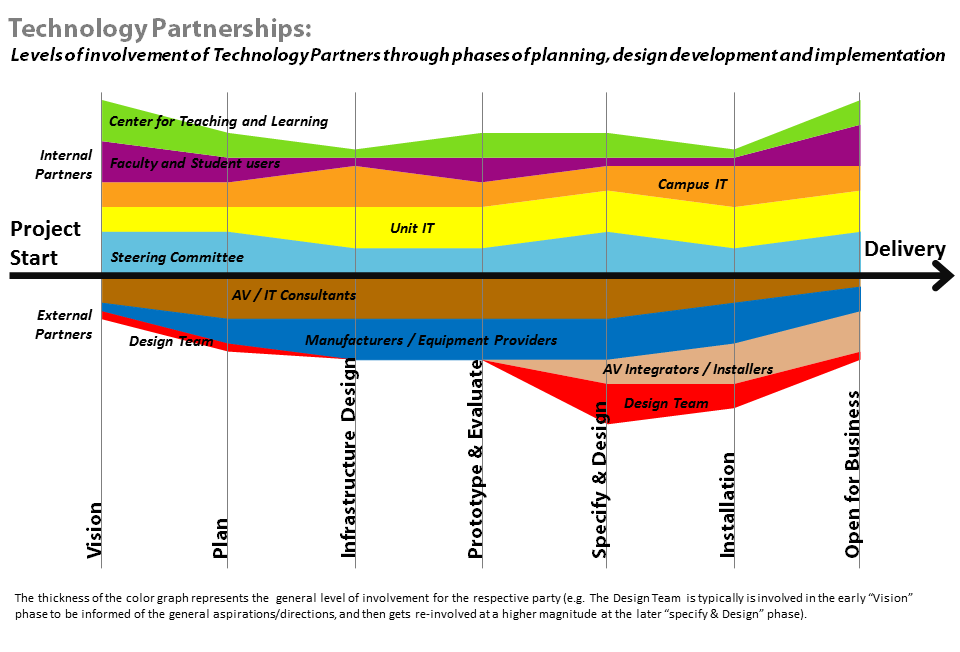Engaging Technology Partners
Designing technology for learning spaces requires working with a wide
range of internal and externalpartners. These include
traditional IT support units (campus IT and your unit’s IT staff); academic
stakeholders (faculty, students, and instructional technologists); and external
stakeholders (technology consultants, integrators, and equipment manufacturers). In
order to be successful, you need to be aware of what pieces of process and
infrastructure each of these partners own, when you should engage them, and how best to
work with them.By their very nature, partnerships need to be sustained over long periods
of time (months or years) through many different phases and levels of engagement. The
art of the partnership is the ability to adapt that narrative to the viewpoint, goals,
and current operational concerns of each partner so as to keep them invested in the
project.

Please click here to view larger
| Partners | Roles | What to know | When to engage |
|---|---|---|---|
| Steering Committee | Steering Committee allocates resources for projects serves as advocate at campus level throughout the project. Their support is critical for realization of the technology vision and effective communication and engagement with this group throughout the vision and design phase is critical. This is the group that will enable resources to be made available during the prototyping stage. | How decisions are made, what the sacred cows are, how the organization is structured in terms of business and culture, and how that will influence different phases of the design and construction of the building. Timing is key–knowing when to present ideas, suggestions, or solutions and when to wait or withdraw. Know how to provide data, what formats are preferred, how to package complex information and scenarios in compact presentations that can be quickly understood. | Engagement and support of the administration is essential throughout the project. |
| Unit IT | Unit IT staff will be responsible for overseeing implementation and supporting the technology spaces. Typically, the project technologist is in the unit’s IT department. If it is located elsewhere, the technologist and project managers will keep unit IT staff informed and connected throughout the project. | What skills and capacity exist in your local IT unit, what kind of services they provide, how far they can stretch to take on new technologies and responsibilities associated with the project. What opportunities are there for services that can be sunsetted or transitioned to reduce workload or costs. Learn the culture of the IT unit and determine the most effective way to work with it, rather than against it. | This can be a delicate balance. Between design and specification stage if the unit IT is not prepared to contribute to the vision stage. Need to develop buy-in. |
| Campus IT | Campus IT manages core infrastructure, such as the network, and is responsible for policies and core services that are applicable to learning spaces (such as security, authentication, printing, file services). Central IT staff can supplement local expertise. | Understand the balance between central and distributed IT in your
environment, what the IT governance structure is like, what the
important committees are, how money is allocated, how decisions are made at a campus level, who the important players are for informal relationships. |
Early in the project, during planning and design phases, and later in the project, during the implementation phase. |
| Faculty and Student Users | Faculty and Student Users are engaged as users of learning spaces. They may use the spaces themselves or indirectly through class assignments that utilize the technology in the learning spaces. | No technical knowledge is necessary, but it is generally good to invite a mix of users, including those who are tech-savy and those without advanced knowledge in technology. | Early in the project, during Needs Assessment and after the project is implemented for Evaluation |
| Center for Teaching and Learning | Center for Teaching and Learning understand use cases related to teaching and learning. They can represent a wide range of users of your learning spaces, and can advise on current and on-the-horizon technologies. They usually manage the Learning Management System as well as classroom technologies, such as “smart” classrooms, clickers, video conferencing, and related technology. | What segment of the faculty/student population the T&L staff serve, what their main services are, what is the relationship to central IT systems and budgeting, where is the core expertise for their staff in terms of educational technology, what kind of collaborations have been successful in the past, what is their relationship with the faculty. | Early in the project, during the vision phase, and again in the prototyping phase. |
| Partners | Roles | When to engage |
|---|---|---|
| AV / IT Consultants | AV / IT Consultants identify specific technology solutions, strategies and products to align with needs and the local technology context. | They will be engaged during the specification and installation process. After opening, they work with you on troubleshooting and adjusting the equipment as users engage with it and issues are identified. |
| Manufacturers/Equipment Providers | Manufacturers/Equipment Providers consult on solutions and supply the equipment. | Prototyping stage. |
| AV Integrators/Installers | AV Integrators/Installers install and integrate all AV components in a space. | They will be engaged during the specification and installation process. After opening, they work with you on troubleshooting and adjusting the equipment as users engage with it and issues are identified. |
| Design Team | Design Team work on furniture, lighting and finishes for spaces and may be involved in the visioninig stage of the project as well. | They will be engaged during the infrastructure design, specification and installation phases to consider options for technology integration in furniture and then integration issues such as cable management. |
| Donors | Donors often have a vision and expectations for the project, and may be providing significant amounts of funding |
